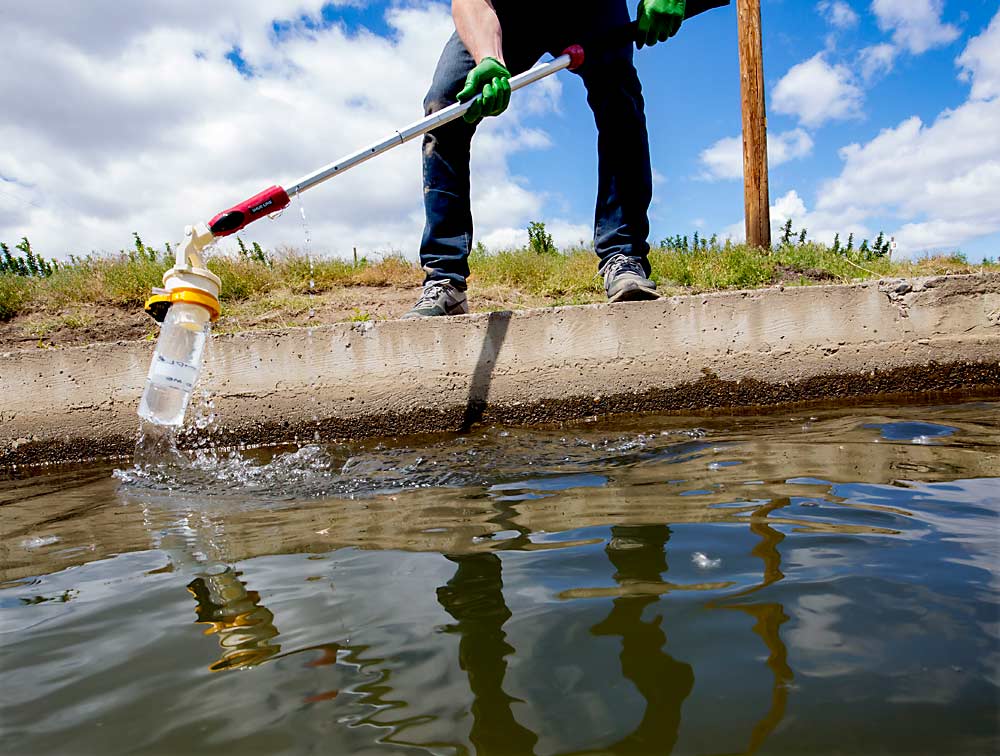
Water testing in irrigation systems to track general coliform presents the best available food safety practice for growers, but it doesn’t detect every pathogen, as the recent E. coli outbreaks in romaine lettuce illustrate. (TJ Mullinax/Good Fruit Grower)
Last year was a bad year for leafy greens growers. Two outbreaks of E. coli contamination that sickened hundreds were linked to romaine lettuce, causing recalls that cost producers millions.
U.S. Food and Drug Administration investigators found a strain of E. coli linked to illnesses in spring 2018 in a Yuma, Arizona, irrigation canal that supplied dozens of farms. In the case of a later outbreak last fall, linked to California farms, they found the same E. coli strain, but with a different genetic fingerprint, in the sediment of a pond on one farm.
However, many questions remain, including in both cases how the pathogen got into the water sources and, therefore, how to prevent further problems.
The experience illustrates a difficult truth: Growers can be doing everything right and still be at risk of a food safety crisis — until the science of prevention catches up with new tools for detecting cases of food poisoning and fingerprinting pathogens.
“We have to do a better job because so much is riding on this,” said Scott Horsfall, CEO of the California Leafy Greens Marketing Association. “We want science-based management, but we don’t understand the science.”
The Northwest Horticultural Council invited Horsfall and Paula Rivadeneira, a University of Arizona extension specialist focused on produce safety, to share insights from their experience with the recent romaine outbreaks with the tree fruit industry at a food safety workshop in March.
“We thought the lessons about how FDA responded to last year’s leafy greens outbreaks — both in terms of the investigation and broad advisories that affected many growers not responsible for the outbreak — would be of value to our industry,” said NHC Vice President Kate Tynan.
“The fact that leafy greens growers sample their water at a rate that exceeds the FSMA requirements, and it is suspected that irrigation water was the source of both of the 2018 outbreaks, is also something our growers should pay attention to, as it will likely affect how FDA moves forward in the agency’s reconsideration of the water requirements in the Produce Safety rule,” Tynan said.
Water testing remains a challenge because irrigation water is tested for total coliform bacteria, not pathogens, Rivadeneira said. It’s too complicated and expensive to look for all the different potential pathogens under routine circumstances, where regulators rely on a spike to indicate risk, but the romaine outbreaks illustrate how the existing methods don’t catch everything.
For the FDA to find the pathogenic strain in the Arizona canal, it took far larger samples and subjected them to much more high-tech testing than will ever be feasible for growers, she said.
Another takeaway from Horsfall and Rivadeneira: the challenge posed by the time it takes health officials to identify an outbreak in the first place.
In this case, it took more than a month for officials to identify an outbreak and trace it back to romaine, at which point, all of the potentially contaminated, highly perishable product had long since been sold. It’s also difficult to trace back accurately — especially in the final mile to the consumer.
“It’s not one’s fault, it just takes time, but that’s why, when they get to doing traceback, they get a lot of crisscrossing lines,” Horsfall said. By the time the recall was issued, in the case of the perishable greens, two months had passed and the lettuce harvest had moved to an entirely different region.
Traceability presents particular challenges in bagged salad production, but Horsfall said it’s an important part of every LGMA member’s operations. It’s important because good traceback can narrow the scope of concern and protect some people, he said, but “from our standpoint, we are trying to do whatever we can do to not have the outbreaks in the first place, because traceback is not the answer.”
More research is needed into how contamination occurs, Rivadeneira said, specific to each crop production and harvest system. For example, she and her colleagues are currently inoculating lettuce with a nonpathogenic strain of E. coli to see if freezing weather conditions that damaged leaf tissues last year could have made the Arizona crop particularly vulnerable to contamination.
A food safety task force that the leafy greens industry set up last year decided on research priorities, she said. It also set out new standards for leafy greens producers’ risk management programs, including larger buffer zones around confined animal feeding operations, or CAFOs, more stringent water treatment standards for surface waters that pass near CAFOs if used for irrigation, and daily cleaning and sanitation of all food contact surfaces during harvest, Horsfall said.
“We’ve got to do a better job communicating with the regulators and federal authorities,” he said, referring to what the greens industry learned from the outbreaks. “We need to make sure we are addressing the issues they are zeroing in on.”
Horsfall also recommended that companies establish crisis plans, and he encouraged them to conduct mock recalls, just in case.
“We’re never going to have zero risk; we grow food outside. I know that’s what everyone wants, they want zero risk, but realistically, how do you do that when you grow food outside and your water is outside and you have people touching things?” Rivadeneira asked. “We try to get as close to zero as possible, but I think it’s unreasonable for the public or anyone to expect us to have zero risk.” •
—by Kate Prengaman






Leave A Comment